ASPE ISSUE BRIEF(*)
Receipt of Unemployment Insurance Among Low-Income Single Mothers
January 2005
This Issue Brief is available on the Internet at:http://aspe.hhs.gov/hsp/05/unemp-receipt/
Printer Friendly Version in PDF
Contents
- Summary
- Introduction
- Increase in Unemployment Insurance Receipt Since 2000
- Eligibility of Low-Income Single Working Mothers for Unemployment Insurance
- The Role of UI Benefits in the Safety Net for Single Mothers
- Conclusion
Summary
This issue brief examines the receipt of unemployment insurance receipt among low-income single women with children. It finds that:
- Receipt of unemployment insurance (UI) benefits increased among low-income single women with children between 2000 and 2003 - in marked contrast to the lack of change in UI receipt among this population during the recession of the 1990s.
- The increase in use of the unemployment insurance system is likely due to the dramatic increase in employment among single mothers with children since enactment of welfare reform in 1996.
- Former welfare recipients who transition from welfare to work appear to have greater access to unemployment insurance in recent years than was true for their counterparts in the 1980s.
- Increased reliance on unemployment insurance as a primary safety net has reduced some of the demand for cash assistance from the Temporary Assistance for Needy Families (TANF) program, contributing to some of the recent decline in TANF caseloads.
Introduction
In August 1996, the Personal Responsibility and Work Opportunity Reconciliation Act (PRWORA) replaced the old cash welfare system, Aid to Families with Dependent Children, with a new program, focusing on work and personal responsibility. Under the new Temporary Assistance for Needy Families (TANF) program, welfare caseloads declined dramatically. Between 1996 and 2003, the proportion of families with children under 18 receiving TANF cash assistance fell in half, from 12.8 percent to 6.0 percent, as shown in Figure A.
Figure A: Trends in TANF Receipt and Unemployment Rates, 1990-2003

Note and source: TANF families are receiving cash assistance funded through TANF or closely related Separate State Programs. See Appendix A for further definitions and source.
The early years of TANF implementation occurred during a period of strong economic growth, reflected in falling unemployment rates, both among the overall population, and, as shown in Figure A, among single mothers with children under 18 those most likely to participate in TANF.(1) While policy changes have played a substantial role in caseload decline, the strong economy also has been credited with facilitating the transition of many welfare recipients from welfare to work, and playing a role in contributing to the unprecedented decline in welfare caseloads. Because the economy was so strong in early years of TANF implementation, some critics of welfare reform questioned whether welfare reform would continue to be a success if the economy were to slow down and unemployment rates were to rise. Would low-income single mothers return to TANF cash assistance and reverse some of the early achievements of welfare reform?
The evidence to date shows little increase in TANF caseload nationally. Between 2000 and 2003, unemployment among single mothers has increased somewhat, yet the TANF caseload has continued to fall, though at a more moderated pace. This divergence in trends between unemployment and TANF caseloads has led to a new question: why have TANF caseloads remained relatively flat, and in fact continued to decline, in a period when there has been some economic downturn and increase in unemployment? The lack of increase in welfare caseloads is particularly remarkable given increases in other measures of need: between 2000 and 2003, there has been an increase in the percentage of the population receiving food stamps and in the poverty rate of female-headed families (see Figure B and Appendix Table B-1).
Figure B: Trends in TANF, Unemployment, Food Stamps, and Poverty
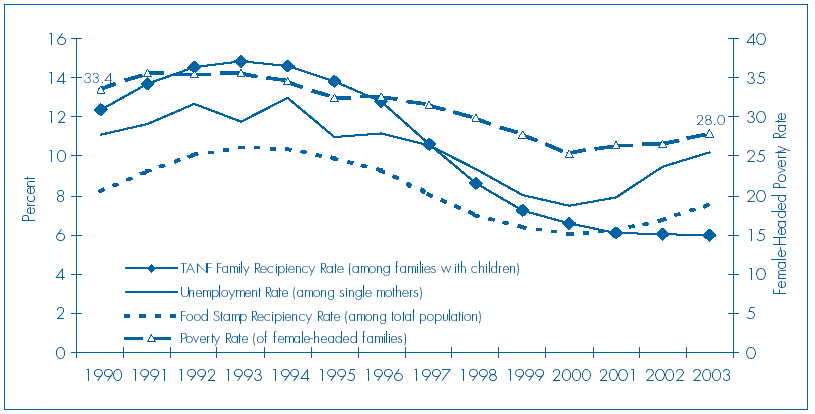
Source: See Appendix A for definitions and sources.
While there are undoubtedly a number of contributing factors, this Issue Brief focuses on one largely overlooked, but significant change in the lives of these women and their families, the increased receipt of unemployment insurance among single mothers with children.(2)
[ Go to Contents ]
Increase in Unemployment Insurance Receipt Since 2000
Between 2000 and 2003, the proportion of low-income single women with children receiving unemployment insurance (UI) benefits at some point in the year increased from 4.6 to 6.7 percent.(3) Generally, it is not surprising to see an increase in receipt of unemployment insurance in times of unemployment. What is important is the increase in the unemployment insurance recipiency rate since 2000 (shown in Figure C) compared to the relatively flat levels of UI receipt throughout the 1990s, despite the recession of the early 1990s.
Figure C: Trends in TANF, Unemployment, and Unemployment Insurance
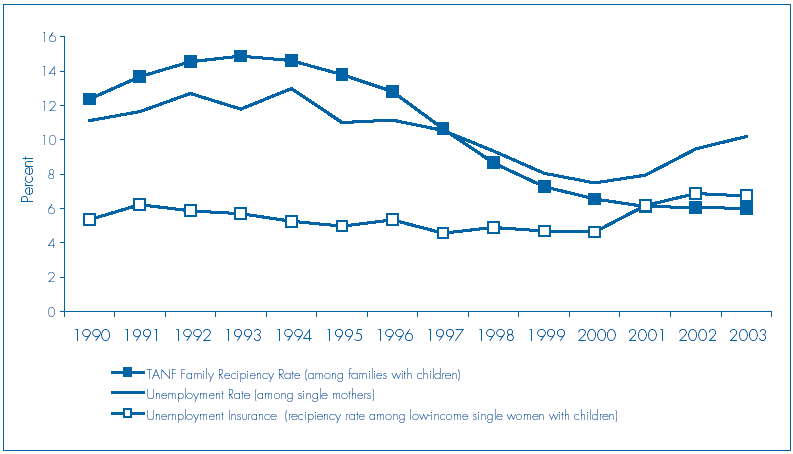
Notes: The TANF family recipiency rate measures average monthlyreceipt of TANF (based on administrative data). In contrast, the UI recipiency rate measures annualreceipt of unemployment insurance rate at any point in the calendar year. Monthly receipt measures are generally lower than annual receipt measures since families do not receive benefits for all 12 months of the year.Monthly administrative data on UI receipt among single mothers are not available. See Appendix A for further discussion of data and sources.
The increase in receipt of unemployment insurance appears to have occurred for single women of various income levels. The trend line is strikingly similar for single women with children below 200 percent of poverty and below 100 percent of poverty, as shown in Figure D. Another important group to examine is single female heads of food stamp households with children under age 18, a group of single women with children that is at high risk for TANF receipt. Analysis of food stamp administrative data indicates that although female food stamp recipients are less likely to receive unemployment insurance than single mothers more generally,the same upward trend is observed.(4) The proportion of single women heading food stamp households with children receiving unemployment insurance has doubled, from about 2 percent during most of the 1990s, to 4 percent in 2003.
Figure D: Unemployment Insurance Recipiency Rates Among Single Women with Children
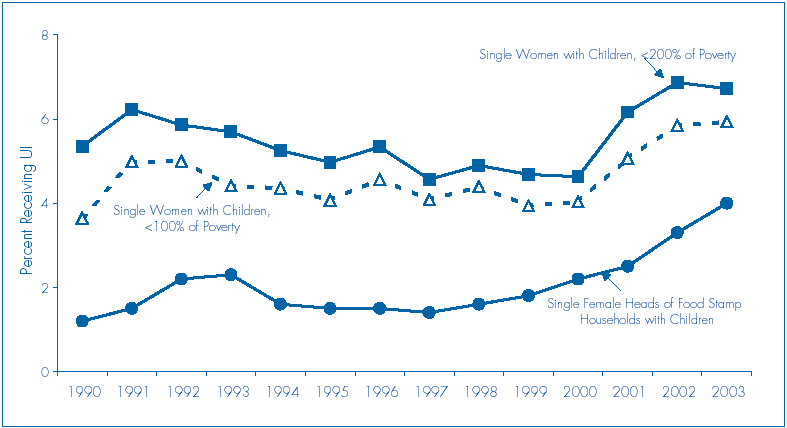
Source: See Appendix A for definitions and sources. Recipiency rate for single female heads of food stamp households in 2003 is based on preliminary data.
The contrast between the early 1990s and the period since 2000 is seen more sharply when comparing the experiences of low-income single women with children to low-income married adults with children (see Figure E and Appendix Table B-2). Receipt of UI benefits among low-income married men with children rose to a peak of over 12 percent in 1992 (the same year that overall unemployment rates peaked), and then fell through the 1990s until it came within one percentage point of the recipiency rate among single women with children. Since 2000, rates for both groups have increased at roughly the same pace. In 2002, for example, the rate of UI receipt was 8.0 percent for married men and 6.9 percent for single women. Rates of UI receipt for married women with children, however, did not show a similar increase. Figure E suggests a shift in the relationship of single women with children to the unemployment insurance system in recent years to one that more closely resemble the experience of low-income married men with children.
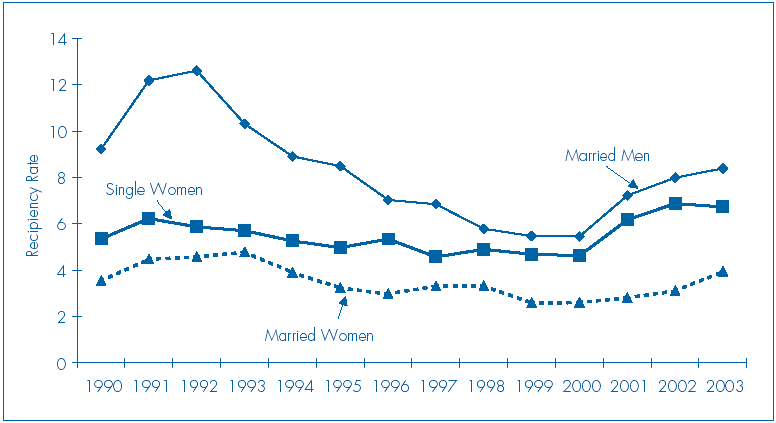
Source: U.S. Bureau of Labor Statistics tabulations of data from the Annual Social and Economic Supplement of the Current Population Survey.
What has changed in the past decade, particularly since the enactment of PRWORA in 1996, is that record numbers of welfare recipients have gone to work. The percentage of adult recipients working while receiving TANF has increased from 11 percent in 1996 to 25 percent in 2002. More generally, the employment rates of never-married mothers with children under 18 those single mothers who have the highest rates of participation in TANF and thus are most likely to be affected by changes in welfare policy has increased at dramatic rate, from 45 percent in 1990 to 63 percent in 2003, as measured by the employment-population ratio (see Figure F). Mothers who were divorced, widowed, or whose husbands were absent, also saw increases (from 68 to 75 percent), though as not as dramatic as never-married mothers. In contrast, the employment-population ratio among married mothers increased only from 64 to 66 percent.
Figure F: Increased Employment of Mothers with Children 18 by Marital Status of Mother
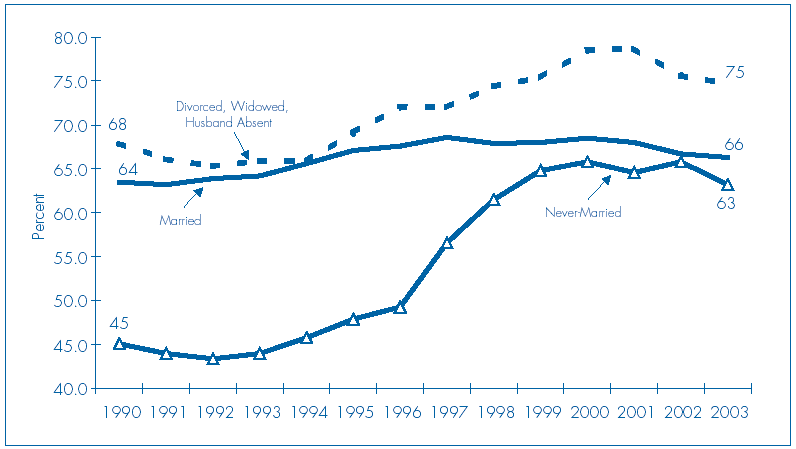
Source: U.S. Bureau of Labor Statistics, unpublished tabulations of data from the Annual Social and Economic Supplement of the Current Population Survey.
These dramatic increases in employment among welfare recipients and single mothers at risk of participating on welfare raise the possibility that a number of them will qualify for unemployment insurance. Eligibility for unemployment insurance is not guaranteed, however. In particular, the low wages and unstable work histories of many former welfare recipients can make it challenging for them to meet the monetary and non-monetary requirements for unemployment insurance, depending on specific criteria set by the states. In terms of monetary requirements, most states require workers to have worked at least two quarters and to earn a minimum amount of earnings in a one-year base period. In addition, workers are not eligible if they quit their jobs without good cause, or are fired for misconduct, and many states require applicants to be available for and seeking full-time work (a non-monetary requirement that can pose particular challenges for mothers of young children). To examine these issues, ASPE sponsored research to study the eligibility of former TANF recipients for unemployment insurance. Findings from this research are summarized below.
[ Go to Contents ]
Eligibility of Low-Income Single Working Mothers for Unemployment Insurance
Researchers at Mathematica Policy Research, Inc. have conducted two separate studies of the extent to which unemployment insurance has the potential to serve as a safety net for women leaving welfare for work. Both studies, one conducted in New Jersey (Rangarajan et al., 2002) and one in sites across five states (Rangarajan et al., 2004) examined the employment and earnings records of TANF recipients after they exited welfare for work, and found that former TANF recipients were more likely to be eligible for UI benefits in the event of unemployment than were former AFDC recipients, based on earlier studies.(5) Both studies found that the majority (90 percent in the five-site study and 75 percent in New Jersey) of former TANF recipients had sufficient earnings to meet the monetary requirements for unemployment insurance at some point during the first two years following their exit for work. The percentage of those potentially eligible at any point in time was lower between 50 to 70 percent in any given quarter of the second year after exit. The authors note that these rates are high compared to earlier estimates of about 33 percent based on studies using data from the mid- and late-1980s. (The New Jersey study covered TANF exits in the late 1990s, and the five-site study covered TANF exits occurring in 1999-2001).
In addition to examining monetary eligibility, the New Jersey study used survey data to look further at the extent to which former welfare recipients meeting monetary requirements for UI benefits also were likely to meet non-monetary requirements (i.e., worker has a qualified work separation and is seeking and available for work, generally full-time work). As many as 60 percent of those with monetary eligibility were estimated as being potentially disqualified for non-monetary grounds (i.e., quitting their jobs or seeking part-time work), leaving a total of 30 percent clearly able to meet both financial and non-financial criteria.(6) Access of former welfare recipients to UI benefits, while not universal, has improved substantially over the past decade.
The trend of increased eligibility for unemployment insurance suggested by the two studies of eligibility of former TANF recipients also can be seen in national data for all unemployed low-income single mothers with children. Among these women, the ratio of those receiving UI benefits during the year to those unemployed during the year increased from 29 percent in 1990 to 40 percent in 2003 (see Figure G).(7)
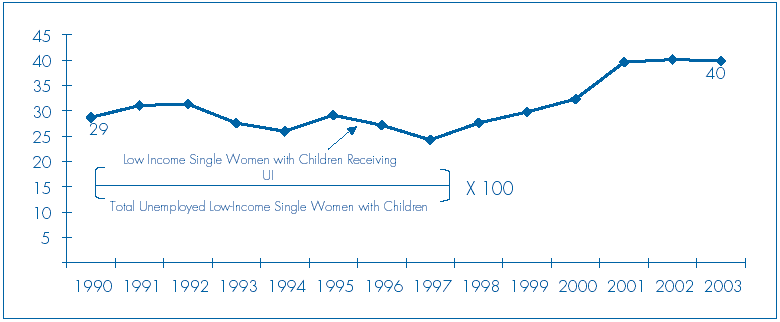
Source: ASPE tabulations of data from the Annual Social and Economic Supplement to the Current Population Survey.
This increase may reflect more work experience and higher earnings among single mothers before they experience unemployment. It also may reflect the increased accessibility of state unemployment insurance systems to low-wage workers. For example, the minimum level of earnings required for UI eligibility has remained unchanged in 21 states over the past ten years essentially lowering the real dollar requirement in comparison to rising wages. Thus more low-income unemployed workers are likely to qualify for unemployment compensation.
[ Go to Contents ]
The Role of UI Benefits in the Safety Net for Single Mothers
The study in New Jersey not only looked at potential eligibility of women leaving welfare work, but also looked at actual receipt of UI benefits. These data also show that unemployment insurance is fairly accessible to former TANF recipients. Over half (53 percent) of those who exited welfare and found work applied for unemployment insurance at some point in the three-year period after TANF exit. Awareness of the UI system and its potential as a safety net program appears high among former TANF recipients in New Jersey (in part due to a program requirement that former workers must file a UI claim before their eligibility for TANF is determined). Furthermore, the study found that over half (56 percent) of claims resulted in actual benefit payments.(8)
For those former welfare recipients who received UI benefits, payments averaged about $860 per month, or twice the level ($424) of the TANF benefit for a family of three in New Jersey in 2001. UI benefits vary from state to state, but the five-state study also found potential UI benefits about twice as high as TANF benefits.Thus, from the perspective of the single motherwho qualifies for unemployment insurance, as well as from the perspective of the welfare agency, UI benefits may be a preferred form of social safety net over cash welfare payments.
Although UI benefits are higher than TANF benefits, they operate under a tighter time limit than the five-year TANF time limit; UI benefits are generally available for only 26 weeks.(9) On average, former welfare recipients in New Jersey collected UI benefits for 16 weeks, receiving slightly less than $3,300 per claim. While it is difficult to compare former welfare recipients in New Jersey to the broader population of low-income single women with children nationally, roughly similar benefit amounts were found in the annual Current Population Survey data. These data show annual benefits among low-income single mothers with children rising in recent years, from less than $2,500 per year through most of the 1990s, to close to $3,800 in 2002 and 2003, as shown in Figure H (all figures are shown in constant 2003 dollars).(10)

Source: See Appendix A for definitions and source.
Income received from the unemployment insurance system is countable when determining a family's eligibility for TANF cash assistance and for food stamp benefits, as well as in calculating official poverty statistics. In most instances, UI benefits raise a family's income above the eligibility levels for TANF cash assistance, and so a family is unlikely to receive both forms of cash benefits in the same month. Food stamp eligibility limits are generally higher, however, and it is not uncommon for low-income families to continue to qualify for food stamp benefits in the same month as collecting unemployment insurance. Also, although UI benefits are twice as high as TANF benefits in many states, they still may not be sufficient to lift a family above poverty (the Federal poverty threshold for a family of 3 in 2003 was $14,680). Thus the increases in female-headed poverty rates and in food stamp recipiency rates observed in Figure B are not inconsistent with the increased use of unemployment insurance.
Although families are unlikely to receive TANF and UI benefits in the same month, these two forms of temporary cash assistance can be complementary in supporting low-income working families. Some low-income single mothers who lose their jobs will likely to turn to TANF cash assistance if their unemployment insurance benefits run out before they find another job, or if they do not qualify for UI benefits. This issue was examined in the New Jersey study, which found that the majority (90 percent) of former welfare recipients who filed a UI claim returned to work during the three-year study period. While nearly two-thirds returned directly to employment, without first turning to TANF, one in four did return to TANF first, either because they did not receive UI benefits, or because their UI benefits were exhausted. Unemployment insurance is by no means the only element of the safety net for single women with children; TANF cash assistance, food stamps, Medicaid, and other non-cash supports also play an important role in supporting low-income working families in times of economic challenge. Yet, since 2000, unemployment insurance has played a larger role in supporting single women with children than is generally acknowledged.
The magnitude of the changes in receipt of TANF and unemployment insurance benefits is shown in Figure I and in Table Appendix B-3. By way of background, between 2000 and 2003, the average monthly number of unemployed single mothers with children rose by 226,000. Over the same time period, the average monthly number of TANF cases decreased by approximately 122,500 and the number of low-income single mothers with children who received unemployment insurance at some point in the year increased by 164,000.(11) Some unknown proportion of these 164,000 low-income single mothers with children was kept off the welfare rolls because of income from unemployment insurance.(12) In other words, if the number of single mothers receiving unemployment insurance had not increased (that is, if UI recipiency rates remained as flat for this population as in the early 1990s), one would have seen more families on TANF in 2003 than actually occurred. While the size of the effect is uncertain, the direction is clear. Increased receipt of unemployment benefits is not the only change affecting TANF caseloads in the post-1996 era, but it is an often-overlooked one. The decline in TANF caseload between 2000 and 2003 would have been smaller or possibly nonexistent but for the increase in unemployment insurance benefits among low-income single women with children.
Figure I: Changes Between 2000 and 2003 in Unemployment, TANF, and Unemployment Insurance
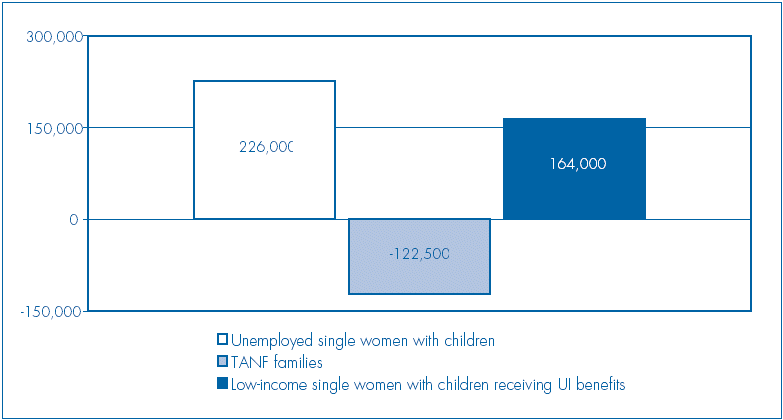
Source: See Appendix A for definitions and sources.
[ Go to Contents ]
Conclusion
This issue brief has examined unemployment insurance receipt among single women with children as a potential explanation for why TANF caseloads have not risen in response to higher levels of unemployment. Analysis of data from the Current Population Survey has shown that receipt of UI benefits increased among low-income single women with children between 2000-2003, in a pattern that is in contrast to lack of increased receipt during the recession of the 1990s. What has changed between the two periods is the enactment of welfare reform and the dramatic increase in employment among single mothers with children, especially among never-married mothers who are most at risk for TANF receipt. Now that so many single mothers are working, many of these new workers are able to qualify for unemployment insurance coverage. Two studies conducted by Mathematica Policy Research for ASPE have documented that significant numbers of women who leave welfare for work are indeed eligible for unemployment insurance. Therefore, during periods of economic difficulty, many single mothers who experience interruptions in their employment have been able to use the unemployment insurance (UI) system as their primary safety net. This increased use of unemployment insurance has reduced some of the demand for TANF cash assistance.
[ Go to Contents ]
Appendix A Definitions and Data Sources
TANF family recipiency rate is based on HHS administrative data on monthly number of families receiving cash assistance through TANF or closely related Separate State Programs, averaged over the calendar year and divided by U.S. Census bureau data on total number of families with children under 18, July 1st of each year. Families in the territories were excluded from the numerator to be consistent with the denominator. Data for 1990-1997 are from the Aid to Families with Dependent Children (AFDC) program, the predecessor of TANF.
Unemployment rate among single mothers with children is based on calendar year averages of monthly unemployment rates for 1995-2003 (unpublished tabulations of CPS data produced by the Bureau of Labor Statistics), but on data for a single month March for 1990-1994 (based on BLS published data). Fluctuations in 1990-1994 are likely due to the use of the single month. Single mothers are women who are the head of household with no husband present, including mothers who are never married, married with spouse absent, widowed, or divorced. Children are own children less than 18.
TANF family recipiency rate. See notes for Figure A.
Unemployment rate among single mothers with children. See notes for Figure A.
Food stamp recipiency rate is based on U.S. Department of Agriculture administrative data on monthly number of individuals receiving food stamps, averaged over the calendar year, divided by U.S. Census bureau data on total population, July 1st of each year.
Female-headed poverty rate is for families with a female householder, no husband present, from U.S. Census Bureaus Income, Poverty, and Health Insurance Coverage in the United States: 2003, P 60-226, Table B-1.
TANF family recipiency rate. See notes for Figure A.
Unemployment rate among single mothers with children. See notes for Figure A.
Unemployment insurance recipiency rate among low-income-single women with children is based on ASPEtabulations of the Annual Social and Economic Supplement of the Current Population Survey. Low-income single women with children is defined as women in households without a husband present (female-heads) in families with income 200 percent of poverty and related children 18. Note that the related children may include nieces, nephews, grandchildren, etc., as well as own children. Note that this recipiency rate includes receipt of unemployment insurance rate at any point in the calendar year. Since families do not receive 12 months of unemployment insurance, it is higher than if receipt had been measured as an average of receipt in each month.
Unemployment insurance recipiency rates among single women with children. See notes for Figure C (rate for those with income 100 percent of poverty calculated in same way as for those with income 200 percent of poverty).
Recipiency rate of unemployment insurance among single female heads of food stamp households with children is based on unpublished Food and Nutrition Service tabulations of data from the Food Stamp Quality Control survey. It is limited to female adults who are the sole adult in the household, representing about one-third of all food stamp households. Children must be less than 18, but may not necessarily be the female heads own child. Recipiency is measured on a monthly basis; the family must receive both food stamps and unemployment in the same month to appear in this table. The 2003 rate is based on preliminary data.
Unemployment insurance recipiency rates among low-income single women with children, low-income married men with children, and low-income married women with children.
See notes on Figure C. Low-income married men and women are defined the same way as low-income single mothers with children - except that the man or woman must be the head or spouse in a family headed by a married couple.
Employment-population ratios are based on unpublished BLS tabulations of mothers' employment by age of own children and martial status, based on data from the Annual Social and Economic Supplement of the Current Population Survey. The employment-population ratio is the proportion of mothers 16 and over that is employed. The three marital statuses shown include: married; never-married; and married with spouse absent, widowed, or divorced.
The ratio of insured employment to total unemployment among low-income single women with children is based on ASPE tabulations of data from the Annual Social and Economic Supplement of the Current Population Survey. The numerator (insured employment) is low-income women with children who receive unemployment insurance at any point during the calendar year (as explained in notes for Figure C). The denominator (total employment) is low-income women with children who experience unemployment at any point during the calendar year. Thus it differs somewhat from measures that examine IUR to TUR ratios at a point in time (but the latter measure is not available by marital status and presence of children).
Average amount of unemployment insurance benefits received by low-income single women with children is based on ASPE tabulations of data from the Annual Social and Economic Supplement of the Current Population Survey. Low-income single women with children defined in notes to Figure C. Average amounts are adjusted to 2003 dollars, using the CPI-U price deflator.
See notes to Figure A for definition and source of unemployed single mothers with children.
See notes to Figure A for definition and source of TANF families, except note families in the territories were not excluded in this figure.
See notes to Figure C for definition and source of low-income single women with children receiving UI benefits.
[ Go to Contents ]
Appendix B Data Underlying Figures
| Year | TANF Family Recipiency Rate | Food Stamp Recipiency Rate | Unemployment among Single Mothers with Children | Unemployment among Single Mothers with Children | Poverty Rate of Female Headed Families |
| CY Average | CY Average | CY Average | in March | Annual | |
| 1990 | 12.4 | 8.2 | 11.1 | 33.4 | |
| 1991 | 13.7 | 9.3 | 11.6 | 35.6 | |
| 1992 | 14.6 | 10.1 | 12.7 | 35.4 | |
| 1993 | 14.9 | 10.5 | 11.8 | 35.6 | |
| 1994 | 14.6 | 10.4 | 13.0 | 34.6 | |
| 1995 | 13.8 | 9.9 | 11.0 | 10.8 | 32.4 |
| 1996 | 12.8 | 9.3 | 11.2 | 10.3 | 32.6 |
| 1997 | 10.6 | 8.1 | 10.5 | 11.9 | 31.6 |
| 1998 | 8.7 | 7.0 | 9.3 | 10.1 | 29.9 |
| 1999 | 7.3 | 6.4 | 8.1 | 8.4 | 27.8 |
| 2000 | 6.6 | 6.1 | 7.5 | 7.5 | 25.4 |
| 2001 | 6.1 | 6.2 | 7.9 | 8.1 | 26.4 |
| 2002 | 6.1 | 6.8 | 9.5 | 9.8 | 26.5 |
| 2003 | 6.0 | 7.6 | 10.2 | 10.8 | 28.0 |
| Year | Low-Income Single Women with Children | Low-Income Married Men with Children | Low-Income Married Women with Children | Food Stamp Households with Children, Headed by Single Women | Average UI Benefit among Low-Income Single Women with Children |
| Any point in year | Any point in year | Any point in year | FY Average | Annual, CY03 Dollars | |
| 1990 | 5.3 | 9.2 | 3.5 | 1.2 | $2,055 |
| 1991 | 6.2 | 12.2 | 4.5 | 1.5 | $2,523 |
| 1992 | 5.9 | 12.6 | 4.6 | 2.2 | $3,154 |
| 1993 | 5.7 | 10.3 | 4.8 | 2.3 | $3,049 |
| 1994 | 5.3 | 8.9 | 3.9 | 1.6 | $2,619 |
| 1995 | 5.0 | 8.5 | 3.2 | 1.5 | $2,291 |
| 1996 | 5.3 | 7.0 | 3.0 | 1.5 | $2,402 |
| 1997 | 4.6 | 6.8 | 3.3 | 1.4 | $2,280 |
| 1998 | 4.9 | 5.8 | 3.3 | 1.6 | $2,267 |
| 1999 | 4.7 | 5.5 | 2.6 | 1.8 | $2,376 |
| 2000 | 4.6 | 5.5 | 2.6 | 2.2 | $2,095 |
| 2001 | 6.2 | 7.2 | 2.8 | 2.5 | $2,775 |
| 2002 | 6.9 | 8.0 | 3.1 | 3.3 | $3,783 |
| 2003 | 6.7 | 8.4 | 3.9 | 4.0 | $3,760 |
| Year | Unemployed Single Mothers with Children | AFDC/TANF/SSP Families | Low-Income Single Women with Children Receiving UI Benefits |
| CY Average | CY Average | Any point in year | |
| 1990 | 4,056,586 | 313,000 | |
| 1991 | 4,497,184 | 381,000 | |
| 1992 | 4,829,098 | 375,000 | |
| 1993 | 5,011,828 | 391,000 | |
| 1994 | 5,032,634 | 345,000 | |
| 1995 | 730,000 | 4,790,751 | 319,000 |
| 1996 | 772,000 | 4,434,162 | 358,000 |
| 1997 | 770,000 | 3,740,176 | 294,000 |
| 1998 | 695,000 | 3,050,340 | 308,000 |
| 1999 | 616,000 | 2,554,072 | 286,000 |
| 2000 | 574,000 | 2,302,786 | 271,000 |
| 2001 | 614,000 | 2,191,509 | 380,000 |
| 2002 | 755,000 | 2,187,159 | 426,000 |
| 2003 | 800,000 | 2,180,254 | 435,000 |
| 2000 to 2003 | 226,000 | -122,532 | 164,000 |
[ Go to Contents ]
Endnotes
1. For the years 1995-2003, unemployment rates for single mothers with children under age 18 are based on calendar year averages, while for the years 1990-1994, unemployment rates are measured using data for a single month March. Fluctuations in 1990-1994 are likely due to the use of a single month. Single mothers are women who are the head of the household with own children under age 18 and no husband present, including mothers who are never-married, married with spouse absent, widowed, or divorced.
2. This brief presents new analysis of data from the Census Bureau's Annual Social and Economic Supplement of the Current Population Survey, supplemented by findings from two ASPE-sponsored research reports conducted by Mathematica Policy Research, Inc.
3. Throughout this brief, low-income is defined as income less than 200 percent of poverty, and single women with children includes women who head families with related children under 18 and have no husband present. Though largely synonymous with single mothers this population also includes some grandmothers, aunts, etc. with related children. As noted before, single means never-married, married with spouse absent, widowed, or divorced.
4. Note that the food stamp administrative data records receipt of unemployment insurance in the same month as receipt of food stamp benefits, whereas the other measures examine receipt of UI benefits at any point in the year. The use of a monthly rather than annual measure of recipiency is one reason the UI recipiency rate is lower among female-headed food stamp cases as compared with low-income single mothers in the general population.
5. Rangarajan, A., Razafindrakoto, C., and Corson, W. (2002), Study to Examine UI Eligibility Among Former TANF Recipients: Evidence from New Jersey and Rangarajan, A. and Razafindrakoto, C. (2004) Unemployment Insurance as a Potential Safety Net for TANF Leavers: Evidence from Five States. The five sites are Maricopa County, AZ; Cook County, IL; Baltimore County, MD; Philadelphia County, PA; and Tarrant County, TX.
6. The authors characterize the 60 percent ineligibility estimate as an upper bound estimate; using it; only 40 percent of the 75 percent who met the monetary criteria (or 30 percent of the total) also met the non-monetary criteria. Note that this rough indicator of eligibility is based on a combination of administrative and survey data from New Jersey, a state that has somewhat more restrictive monetary UI eligibility rules than other states, but somewhat less restrictive non-monetary rules.
7. Among all low-income adults 15 and older, the ratio increased from 40 percent in 1990 to 51 percent in 2003. This ratio is based on calculations of the Annual Social and Economic Supplement to the Current Population Survey, examining those receiving unemployment insurance at any point in the previous calendar year and those unemployed at any point in the previous year. Therefore it differs somewhat from the traditional ratio of those receiving UI benefits at a particular point in time as a percentage of those unemployed at the same point in time.
8. Over half of those who filed one claim filed a second one, and so some former recipients may have received payments under two different claims over the three-year period.
9. Though much shorter than the five-year time limit in TANF, the UI time limit is different in being renewable; once a worker meets the necessary requirements for a new work history, the worker is again eligible for full benefits.
10. An increase in annual benefits can result from an increase in the duration of benefit receipts as well as a change in the size of weekly benefits.
11. Monthly measures of UI receipt would be more comparable to the first two bars, but such measures do not exist by family structure and presence of children. Also note that although most of the TANF cases in the second bar involve female-headed families, an estimated 3,600 TANF cases in the decline are officially classified as two-parent cases. (In addition to the formal two-parent classification, there are other cases that may involve married couples, e.g., children living with married grandparents or with non-citizen married parents who are not part of the TANF unit). Finally, the average monthly unemployment measure in the first bar is not limited to those below 200 percent of poverty. However, there was a similar increase (240,600) between 2000 and 2003 in single mothers below 200 percent of poverty when measured as mothers experiencing unemployment at any point during the year.
12. While unknown, the proportion is clearly not 100 percent or 0 percent. Some women would have sufficient assets or income to be disqualified from welfare even without unemployment benefits; some would not turn to welfare in any case due to stigma, cultural values or preference for other sources of support; and some might turn to welfare later in the year. On the other hand, the cash income provided by unemployment insurance would eliminate some women's need for any welfare during periods of unemployment.
[ Go to Contents ]
The issue brief presents analysis of data from the Census Bureaus Annual Social and Economic Supplement of the Current Population Survey, supplemented by findings from two ASPE-sponsored research reports conducted by Mathematica Policy Research, Inc.
By focusing on increased receipt of unemployment insurance, this Issue Brief highlights a largely overlooked, but significant, change in the lives of single women and their families.
Office of the Assistant Secretary for Planning and EvaluationOffice of Human Services PolicyUS Department of Health and Human Services Washington, DC 20201
Michael J. OGrady, Ph.D Assistant Secretary
Don Winstead Deputy Assistant Secretary for Human Services Policy
